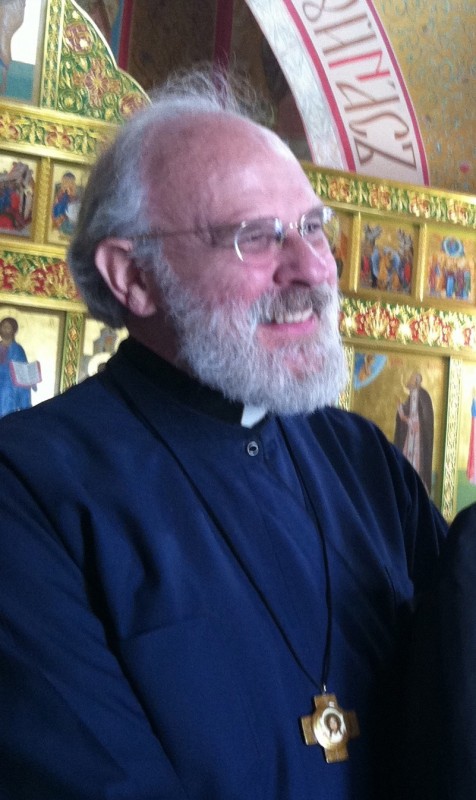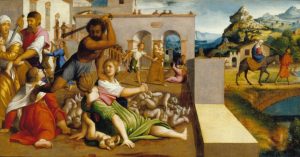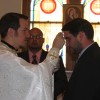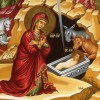Fr. Brendan Pelphrey is a priest of the Greek Orthodox Archdiocese of America, serves as presiding priest at St Sophia Greek Orthodox Church in San Antonio, Texas.
One of the objections to Christian faith which is frequently heard at Christmas is that Jesus’ birth and ancestry are inconsistent with each other. Matthew, for example, tells us about Joseph’s dreams and also about the visit of the magi (Persian astrologers); but Luke doesn’t mention these things. Luke’s Gospel, on the other hand, tells much about the birth of John the Baptist and about shepherds who saw angels on the night of Jesus’ birth–but these are not mentioned by Matthew. Mark does not say anything at all about the birth of Jesus. John confines himself to the theological proposition that “the Word became flesh,” without any documentation about where, or how, or when Jesus was born.
These differences are sometimes taken for evidence that the accounts of Jesus’ birth were simply made up in later years. A similar view, generally accepted among European and American theologians, is that the accounts are meant to be symbolic rather than historical. Therefore (the argument goes), the story about the shepherds and the angels is not “real,” but simply part of a primitive motif of oral tradition: the “shepherds” mean that Jesus came for the poor, while the angels indicate approval in heaven.Similar explanations have been put forward for every detail of Jesus’ birth, including the trip to Bethlehem, Jesus’ birth in an animal stall, the visit by the magi, the flight to Egypt, and the killing of the infant boys by Herod.
The greatest objection to taking the gospel accounts seriously, however, has to do with the accounts of Jesus’ ancestry. The Gospel of Matthew begins with a genealogy tracing Jesus’ lineage back to the time of the Patriarch Abraham Matthew 1:2-17). The Gospel of Luke also records a genealogy, this time stretching back to Adam Luke 3:23-38).Anyone who has ever read these two genealogies cannot fail to notice that the lists are different.Luke’s list, moreover, seems far too short to stretch back to the beginning of time.
The problem of the different genealogies was recognized from early times.In his Church History the historian Eusebius (d. 340) explains the differences, but Christians may have disputed the issue much earlier. St. Paul wrote to Timothy, for example, to charge certain persons not to teach different doctrines nor to occupy themselves with “endless genealogies which promote speculations rather than the divine training which is the faith” (1 Timothy 1:3-4). Was this a reference to discussions about the genealogy of Jesus Christ?
In any case, the simplest explanation is that Matthew traces Jesus’ genealogy through Joseph, while Luke traces Jesus’ family history through His mother, Mary. It is sometimes noted in commentaries that in Jewish practice, Mary’s genealogy would actually be in her husband’s name.This means that Mary’s genealogy begins with Joseph, her husband.He is called “the son of Heli,” which today would be expressed as “Heli’s son-in-law.” Joseph’s own father was Jacob (Matthew 1:16). Unfortunately, this explanation is not entirely satisfactory for a number of reasons (for example, tradition says that Mary’s father was named Joachim)–although the genealogies of some women are presented in the Old Testament (cf. Number 26:33, 1 Chronicles 2:16-17, 8:11).
We note, however, that Matthew’s Gospel was probably composed in Aramaic, intended for Jews in Judea and Galiliee.It emphasizes Jesus’ fulfillment of the Mosaic Law; therefore, Matthew traces the genealogy to Abraham, Patriarch of the Jews, showing that Jesus is descended from the House of David. Luke, on the other hand, is writing in Greek for fellow Gentiles. His purpose is to show that Jesus is the Savior who has come for the Gentiles as well as for the Jews. Therefore he traces the ancestry back to Adam, “the son of God,” emphasizing that Jesus too had no earthly father. In the practice of the time, it would not have been necessary to name every generation. The intent, in both gospels, was to highlight the most important or significant names.
Another factor is the Jewish practice known as “levirate marriage.” Jewish genealogies were sometimes traced through the biological father, and other times through the legal (not biological) father. The reason is recorded in Deuteronomy 25:5-10. According to this requirement of the Law of Moses, if a married man died without a male heir his brother (or nearest male relative) had the responsibility to marry the widow and to provide a son for her. The son would be given the name of the woman’s first husband.In that way, the name of the original husband would be perpetuated. By custom, this legal relationship was more important than the biological one. If this is what happened in the case of Joseph, he would have only one paternal grandfather–recorded by Matthew as “Matthan” and by Luke as “Matthat” (the different spellings being due to variations in the way Aramaic, Hebrew and Greek names were rendered in translation). In both gospel accounts of the birth of Jesus, of course, Joseph is portrayed as the legal–not the biological–father of Jesus.
The omission of some of the names is most likely due to problems in the texts which were handed down. For example, Melchi–given as the third from the end in some texts of the Gospel of Luke–is given in our present text as fifth from the end. In-between are Matthat and Levi, whose names have accidentally dropped out of some copies of the text (for example, that followed by Julianus Africanus, d. 240).
Eusebius discusses this whole problem, noting that the preservation of any genealogy at all would have been very difficult, and is the reason for recording the genealogies in the gospels. Herod, who had been appointed ethnarch (king) by the Roman government, was not actually of Jewish descent. Attempting to hide this serious difficulty, he ordered that all genealogies should be burned. Early Christians saw in this historic event the fulfillment of a prophecy of the Messiah, who would come when the king would no longer be of Jewish descent (Genesis 49:10).
Actually, the gospels are very reliable in terms of recording historic events.Some of these have only recently been corroborated by extra-biblical disciplines, and explain apparent problems in the biblical texts. For example, Herod the Great died in 4 B.C. Does this mean that the gospel accounts are inaccurate in the claim that he was king, and killed the innocent boys in Judea? Not really.
Roman records show that a census was taken every fourteen years, and one of these occurred about the year 7-6 BC. At that time the governor of Syria was the Roman senator Publius Sulpicius Quirinius (a paving-stone with his name carved on it was discovered by archeologists only a few years ago)–whose name appears as “Cyrenius” in the King James Bible. Studies have shown that errors in the calculation of years in the Christian calendar (introduced by Dionysios the Younger in 526 AD) indicate that Jesus was born in the year 747 or 748 in the Roman calendar, not 754 as Dionysios thought. Therefore, Jesus would have been born six or seven years earlier than our present calendar suggests–during the reign of Herod the Great.
Finally, there are many other evidences for the historic truth of the gospel accounts (including the appearance of the bright star in the heavens in around 5 BC, the visit of the Magi and so on). But Christians know that the Truth that saves is of an even greater order. Jesus said, “I am the way, the truth, and the life.” Orthodox who want to respond to modern urban legends about Christmas should begin by remembering why God became incarnate in the first place: that we might be reconciled to Him!
[To read more about the above, see: Eusebius, Church History, which is available as Volume 1 in the Nicene and Post-Nicene Fathers series edited by Philip Schaff; and The Life of the Virgin Mary, the Theotokos edited and published by Holy Apostles Convent and Dormition Skete, Buena Vista, Colorado.]




















